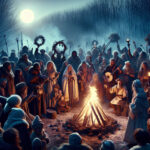The holiday season is in full swing, and with it comes the age-old question: is Santa Claus a pagan symbol? This article will explore the history of Santa Claus, focusing on the pagan roots of the legend and its evolution into a beloved holiday figure. We will examine the evidence of Santa’s pagan connections and discuss how they have impacted the modern celebration of Christmas. Finally, we will consider the implications of Santa Claus as a symbol of a pre-Christian religion.
Santa Claus is a legendary figure originating from the Western Christian tradition, said to bring gifts to the homes of the good children during the late evening and overnight hours on Christmas Eve, December 24. Santa Claus is generally depicted as a jolly, portly, white-bearded man wearing a red coat with white fur trim, white-fur-cuffed red trousers, a red hat with white fur, and black leather belt and boots. He carries a bag full of gifts for children.
What is the origin of Santa Claus?
Santa Claus is based on the Dutch version of the character Sinterklaas, whose modern form is based on Saint Nicholas, a 4th-century Christian saint from the Greek colony of Myra, in modern-day Turkey. Later versions of Sinterklaas were influenced by the British figure of Father Christmas. Santa Claus is also said to be based on Odin, the god of Norse mythology.
Is Santa Claus a pagan symbol?
No. While some of the aspects of Santa Claus may have their roots in pagan traditions, the modern figure of Santa Claus is based on the Christian Saint Nicholas and other Christian traditions. Santa Claus is a secular figure whose purpose is to bring joy to children and to spread goodwill and cheer.
What is the history of Santa Claus?
The modern figure of Santa Claus is largely based on the Dutch figure of Sinterklaas, which was brought to the United States by Dutch immigrants in the 19th century. Santa Claus was popularized in the United States by the 1823 poem “A Visit from St. Nicholas” (also known as “The Night Before Christmas”) by Clement Clarke Moore. In the poem, Santa Claus is described as a jolly, portly man who arrives in a sleigh pulled by eight reindeer and brings gifts to children.
What is the modern Santa Claus like?
Today, Santa Claus is typically portrayed as a jolly, portly, white-bearded man wearing a red coat with white fur trim, white-fur-cuffed red trousers, a red hat with white fur, and black leather belt and boots. He carries a bag full of gifts for children. He is often accompanied by elves or other Christmas figures, such as Mrs. Claus, Rudolph the Red-Nosed Reindeer, and the Gingerbread Man.
Does Santa Claus bring gifts to all children?
Santa Claus is said to bring gifts to all good children on Christmas Eve. However, the exact criteria for being “good” can vary from place to place. Generally, Santa Claus will bring gifts to all children who have been obedient and well-behaved throughout the year.
Does Santa Claus exist?
Santa Claus is a fictional character, and does not exist in physical form. He is a symbol of the spirit of giving and goodwill that is associated with the holiday season, and is a popular figure in many cultures around the world.
In conclusion, Santa Claus is a complex figure with a long and varied history. While he has been associated with Paganism in some cultures, the modern image of Santa Claus is largely based on Christian and secular traditions. He has become an important symbol of the holiday season and a source of joy for children of all ages. Ultimately, Santa Claus is a symbol of love, joy, and giving, and his message of hope and goodwill is something that everyone can appreciate. No matter his origins, Santa Claus is an important symbol of the holiday season that continues to bring joy to people around the world.





